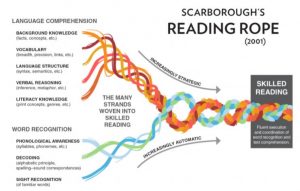Let’s talk about the science of reading
Let’s talk about it…The Science of Reading
“Old and new make the warp and woof of every moment. There is not a thread that is not a twist of these two strands.” -Ralph Waldo Emerson
When my son was 3, he was diagnosed with Type 1 Diabetes. His treatment regimen was grueling and painful, consisting of at least 10 needle pricks each day to monitor his blood sugar and administer insulin. That was a lot for a three-year-old to deal with, and it was a lot for his parents to deal with, too.
Today, with technology and the development of a new bionic pancreas, his treatment protocol is very different. He has real-time knowledge of his blood sugar, and insulin is automatically delivered to him through his insulin pump. However, the fact remains that he requires daily doses of insulin to keep him alive.
The Value of Education Research
Education is the same. New research and old research, combined, have given us a greater opportunity to understand how children learn to read, and teachers understand the value of solid and informative research. I’ve never spoken to a teacher who isn’t committed to improving instruction and incorporating best practices in every lesson. Yet, across the country, there is a gap between research-aligned practices and everyday instruction.
This lack of research does not reflect on the quality of teaching I see wherever I go – teachers are dedicated! Educators are overwhelmed with the increasing demands of their assignments. They do not have access to the vast amount of research tucked away in hundreds of scientific and academic journals in faraway libraries. Despite this, they do incredible work with the information they have available to them.
We must take time to learn about these studies and how they affect our instructional practices and integrate what we “have always known” about reading with what we now know about reading and put those practices into action. Teaching children to read and write is a complicated process, but Maya Angelou said it best, “Do the best you can until you know better. Then when you know better, do better.”
The Science of Reading is decades of research and knowledge about how children learn to read. Years of empirical studies give us a deeper understanding of our students’ processes and skills to understand the meaning of printed words. It is not a slick, packaged program, marketed to school districts and sold on the internet. It is a body of research conducted over 50 years that has expanded and changed. The information we’ve uncovered about literacy acquisition should be incorporated into our daily instructional routines and practices. It doesn’t mean that teachers have to change everything they do.
The Reading Rope
In 2001, Dr. Hollis Scarborough created an infographic depicting the complex processes required to understand printed text. She specifically noted the importance of language acquisition and word recognition in the process of learning to read. We call those skills Foundational Skills. We now have a better understanding of the role that foundational skills (letter name/sound knowledge, phonological awareness, phonics, and word recognition) play in how a child learns to read and comprehend. These early skills are critical in the early development of word reading and writing. This means that we have some essential skills that students must master in kindergarten and first grade (Scarborough, 2001). It’s a big deal! Our instruction in Foundational Skills needs to be intentional, explicit, and systematic in the early grades.
However, Foundational Skills are not, in totality, what children need when they’re learning to read. It is crucial that literacy instruction also includes the explicit teaching of vocabulary, fluency, comprehension strategies, and text structures. Understanding that children must remain engaged in their work by giving them a choice and a voice creates an opportunity for a deeper and more meaningful learning experience.
Foundations of Literacy
In Foundations of Literacy, we will take a deep dive into the Science of Reading and how it impacts instructional design and delivery. We will examine the empirical research and what it says to teachers in the 21st-century classroom throughout the course. We will also address the importance of quality instruction in phonological awareness and phonics (sounds and spellings). Additionally, we will focus on understanding and incorporating Scarborough’s Reading Rope literacy model, paying particular attention to the word recognition strands.
This course is for K-2 teachers looking to improve their instructional practices in reading and writing. Join us in October as we work to understand the research and apply it in our classrooms. Register today for license renewal or graduate credit! (Course Number: 202540, Section Number: 309346).
Scarborough, H. S. (2001). Connecting early language and literacy to later reading (dis)abilities: Evidence, theory, and practice. In S. Neuman & D. Dickinson (Eds.), Handbook for research in early literacy (pp. 97-110). New York: Guilford Press.
For more information, please contact Teri Boezinger.

